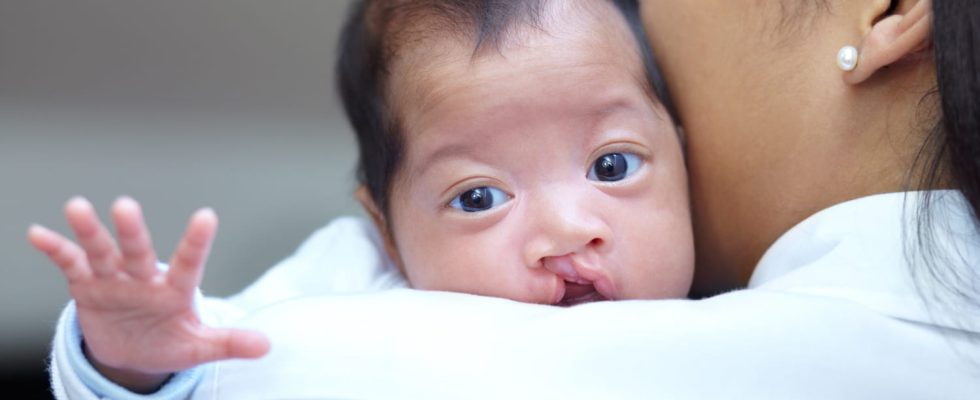Cleft palate or lip and palate is a congenital malformation of the palate and lip. It is the most common facial malformation in newborns. We used to speak of “hare beak”.
Definition: what is a cleft lip and palate?
The “hare lip” is a incorrect term, although it is still widely used. We have to talk about “cleft lip and palate” to designate an absence of fusion of the embryonic tissue of the face. This malformation seems to take place in children very early in pregnancy (between the 4th and 7th week). Physically, this means a slit extending from the nostril to the mouth. More than just an aesthetic problem, cleft lip and palate puts the nose and mouth in direct communication. “This malformation may concern the lip and the palace (hard and soft) together or only the lip or the palate and it can be unilateral or bilateral, complete and incomplete. The deformation of the nose is associated with the cleft lip and palate but it is more precisely what is called a deviation because the nose presses against the maxilla which, divided by a cleft, pulls the nose “, comments Dr. Federica Maggiulli, pediatric plastic surgeon at Montpellier University Hospital. The cleft lip and palate is the most common facial malformation in newborns. Its prevalence would be1 in 700 births. Isolated cleft palate is more common than unilateral or bilateral isolated cleft lip or full lip and palate.”
Diagram: What does a cleft lip and palate look like?
What are the causes of cleft palate?
The causes are unknown. We mention:
- Genetic factors : if a family member has a cleft lip +/- palate, it increases the risk of having a baby with a cleft.
- Taking medication during pregnancy: Retinoidsanticonvulsants, corticosteroids, Benzodiazepines.
- Maternal illnesses or behaviors :diabetes, gestational diabetes, alcohol and tobacco useobesity, folic acid deficiency (B9) or a excess vitamin A during pregnancy.
What is the support?
The multidisciplinary prenatal diagnosis center or the attending physician must send the child to the nearest competence or reference center for a comprehensive management of malformation. In France, these centers are normally found in university hospitals recognized at ministerial level for the multidisciplinary treatment of facial malformations. “We talk about comprehensive care becausea large number of different specialists must be involved on a child with a facial deformity. The multidisciplinary team follows the patient and the family from birth to adulthood. These different specialists intervene at various times in the life of the child according to the priorities of growth.explains the specialist. Here are the doctors likely to intervene: the neonatologist; THE plastic, maxillofacial or pediatric surgeon with specific and recognized training in reconstructive cleft surgery; the pediatric anesthesiologist ; pediatric ENT; the pediatrician; the pediatric orthodontist; the speech therapist for swallowing and language; physiotherapist and psychologist.
“The lip and the nose can be operated from 3 months. The palate from 6 months.”
From what age to operate a cleft lip? From the palace ?
It depends on the protocol and the technique adopted by the surgeon. “The lip and the nose can be operated from 3 months and in this case the hard palate can also be repaired at the same time. The soft palate can be repaired from 6 months. notes the pediatric plastic surgeon. In other words, it means that the malformation is normally corrected during the child’s first year of life. “There decision timing for surgery depends on the general health of the child. THE primary operations can be followed by secondary operations. In the complete labio-palatal forms, the alveolar bone, gingival, can be operated from 5 years old and is normally preceded by orthodontic treatment. After a detailed speech and medical evaluation, it may be necessary to re-operate the veil, normally before the age of 6 years. It is then a surgery to lengthen the palate or a pharyngoplasty“, continues Dr. Federica Maggiulli. Both procedures aim to improve the child’s nasal phonation. Other secondary surgeries such as rhinoplasty or a maxillofacial intervention in case of dental malocclusion at the end of growth can be considered.
What does cleft lip surgery involve?
“The operations are based on the reconstruction of the labial, nasal and palatal anatomy (at the level of the skin, the muscles and the mucous membranes) in order to restore normal oral function as well as facial symmetry” explains the specialist. The operation takes place under general anesthesia.
What before and after results?
Desirable outcomes are: a normal facial appearance with a facial symmetry and one good use of speech. “These two aspects are very important to give the child an ordinary social life. In addition, the labial scar is very little visible, a slight nasal deviation may nevertheless remain” concludes the pediatric plastic surgeon.
Thanks to Dr Federica Maggiulli, pediatric plastic surgeon at Montpellier University Hospital.
